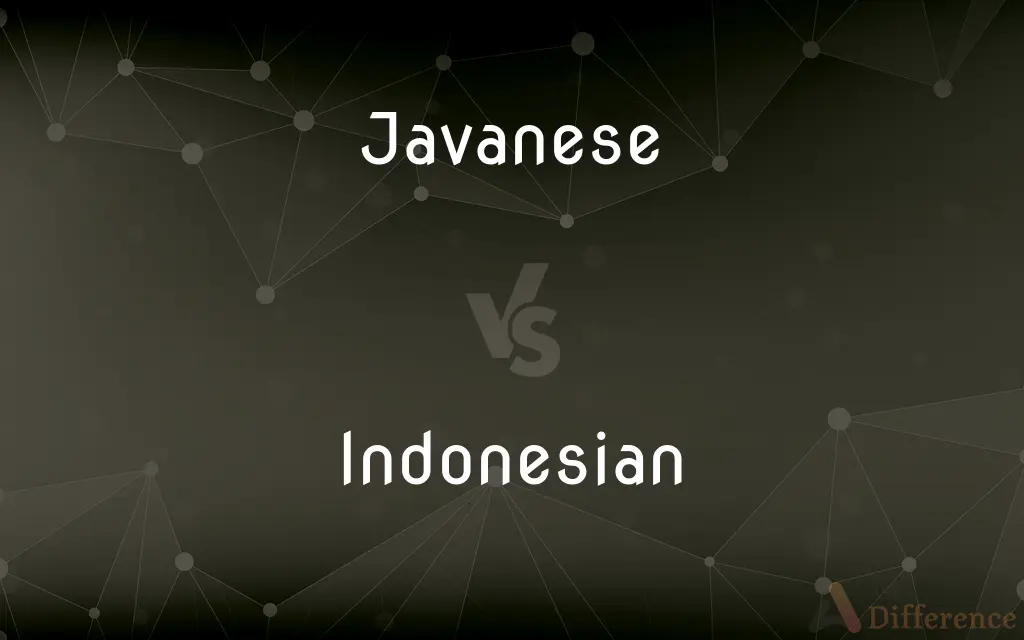Javanese vs. Indonesian — What's the Difference?
By Fiza Rafique & Urooj Arif — Updated on April 30, 2024
Javanese is a regional language of Indonesia, with complex linguistic levels based on social hierarchies; Indonesian is the national language, used universally across the country and featuring simpler linguistic structures.

Difference Between Javanese and Indonesian
Table of Contents
ADVERTISEMENT
Key Differences
Javanese is primarily spoken in the central and eastern parts of the island of Java and is characterized by its complex social levels which affect language usage. In contrast, Indonesian serves as the official national language of Indonesia and is used as a lingua franca among the diverse ethnic groups throughout the archipelago.
Javanese language possesses a system of linguistic etiquette known as unggah-ungguh, which requires speakers to use different levels of speech depending on the social status of the people they are speaking to. Whereas Indonesian does not incorporate such levels and promotes uniformity in speech across different social contexts.
Javanese script, historically derived from the Brahmi script of ancient India, has seen a decline in everyday use, replaced by the Latin alphabet for most practical purposes. On the other hand, Indonesian has always utilized the Latin script, facilitating its role as a tool for national integration and education.
The vocabulary of Javanese is enriched with many words from Sanskrit, reflecting its historical Hindu-Buddhist influences, whereas Indonesian vocabulary is heavily influenced by Dutch, owing to the colonial history, and also integrates many Arabic, English, and local terms.
While Javanese retains a strong cultural identity with traditional Javanese performing arts and literature, Indonesian is designed to be culturally neutral and aims to foster national identity and unity among Indonesia’s diverse ethnic groups.
ADVERTISEMENT
Comparison Chart
Geographical Use
Central and Eastern Java
All of Indonesia
Script
Historically Javanese script, now mostly Latin
Latin
Language Levels
Yes (unggah-ungguh)
No
Vocabulary Influences
Sanskrit, Old Javanese
Dutch, Arabic, English, Local Terms
Cultural Role
Strong cultural identity with regional significance
Culturally neutral with national significance
Compare with Definitions
Javanese
Pertaining to the culture or language of Java’s Javanese people.
Javanese dance forms are integral to their cultural festivals.
Indonesian
The official language of Indonesia, a standardized form of Malay.
Indonesian is used in governmental communications.
Javanese
The Austronesian language spoken by the Javanese people.
Javanese is taught in local schools to preserve the language.
Indonesian
Related to the culture or people of Indonesia.
Indonesian music includes diverse traditional styles.
Javanese
A member of the ethnic group native to Java, Indonesia.
The Javanese are known for their distinct cultural practices.
Indonesian
Pertaining to anything originating from Indonesia.
Indonesian cuisine is rich with spices.
Javanese
A system of refined linguistic etiquette inherent to Javanese.
Understanding Javanese levels of speech requires cultural immersion.
Indonesian
Used across Indonesia for interethnic communication.
Indonesian facilitates dialogue between the country’s many ethnic groups.
Javanese
Relating to Java and its inhabitants.
Javanese batik patterns are recognized worldwide.
Indonesian
A citizen of Indonesia or of Indonesian descent.
Indonesians celebrate Independence Day every August 17th.
Javanese
A native or inhabitant of Java, or a person of Javanese descent.
Indonesian
A native or inhabitant of Indonesia.
Javanese
The Indonesian language of central Java, spoken by about 70 million people.
Indonesian
A person of Indonesian ancestry.
Javanese
Relating to Java, its people, or their language.
Indonesian
A native or inhabitant of the Malay Archipelago.
Javanese
Of or relating to Java or its people, language, or culture.
Indonesian
A subfamily of Austronesian that includes Malay, Tagalog, and the languages of Indonesia.
Javanese
A native or inhabitant of Java, especially a member of the Javanese-speaking majority population.
Indonesian
A dialect of Malay that is the official language of Indonesia. Also called Bahasa Indonesia.
Javanese
The Austronesian language of the principal ethnic group of Java.
Indonesian
Of or relating to Indonesia, the Indonesians, or their languages or cultures.
Javanese
Of or pertaining to Java, or to the people of Java.
Indonesian
Of or pertaining to Indonesia or Indonesians.
Javanese
A native or inhabitant of Java
Indonesian
A member of a race forming the chief pre-Malay population of the Malay Archipelago, and probably sprung from a mixture of Polynesian and Mongoloid immigrants. According to Keane, the autochthonous Negritos were largely expelled by the Caucasian Polynesians, themselves followed by Mongoloid peoples of Indo-Chinese affinities, from mixture with whom sprang the Indonesian race.
The term Indonesian, introduced by Logan to designate the light-colored non-Malay inhabitants of the Eastern Archipelago, is now used as a convenient collective name for all the peoples of Malaysia and Polynesia who are neither Malay nor Papuans, but of Caucasic type. . . . The true Indonesians are of tall stature (5 ft. 10 in.), muscular frame, rather oval features, high, open forehead, large straight or curved nose, large full eyes always horizontal and with no trace of the third lid, light brown complexion (cinnamon or ruddy brown), long black hair, not lank but often slightly curled or wavy, skull generally brachycephalous like that of the melanochroic European.
The Indonesians [of the Philippines], with the tribal population of some 251, 200, live almost exclusively on the great island of Mindanao. They are not only physically superior to the Negritos, but to the peoples of the Malayan race as well, and are, as a rule, quite intelligent.
Javanese
The Indonesian language spoken on Java
Indonesian
A native or inhabitant of Indonesia.
Javanese
Of or relating to or characteristic of Java or its inhabitants;
Javanese temples
Javanese dialects
Indonesian
A native or inhabitant of Indonesia
Indonesian
The dialect of Malay used as the national language of the Republic of Indonesia or of Malaysia
Indonesian
Of or relating to or characteristic of Indonesia or its people or languages
Common Curiosities
Is Indonesian difficult to learn for Javanese speakers?
Indonesian is generally easier for Javanese speakers due to its simpler structure and widespread use in media and education.
Are Javanese and Indonesian mutually intelligible?
They are not mutually intelligible; each language requires separate learning due to distinct vocabulary and structure.
What is the primary use of Javanese?
Javanese is primarily used for cultural and regional communication within the Javanese communities in Java.
How many people speak Javanese?
Approximately 82 million people speak Javanese, making it one of the most spoken languages in Indonesia.
What is the historical origin of the Javanese language?
Javanese developed from Proto-Austronesian, influenced by Sanskrit through historical Indian contact.
How is Javanese written today?
Today, Javanese is mostly written using the Latin alphabet, although traditional script still exists for cultural purposes.
Why is Indonesian considered culturally neutral?
Indonesian was developed to be neutral among the country's ethnic groups to promote national unity.
How does the writing system affect the preservation of Javanese?
The shift from traditional to Latin script in Javanese has impacted the preservation and teaching of cultural heritage.
Is Javanese still taught in schools?
Javanese is taught in regional schools in Java but is less emphasized compared to Indonesian.
What role does Indonesian play in Indonesia?
Indonesian acts as the lingua franca that unites the diverse ethnic groups across Indonesia.
What are the main influences on Indonesian vocabulary?
Indonesian vocabulary is influenced by Dutch, Arabic, and local languages, reflecting its historical and cultural interactions.
What is the global reach of Indonesian?
Indonesian has a limited global reach, mainly used among the Indonesian diaspora.
Do Javanese speakers use Indonesian daily?
Javanese speakers often use Indonesian in formal and interethnic interactions.
Can learning Indonesian help in understanding Javanese culture?
While it provides a linguistic foundation, understanding Javanese culture deeply requires learning specific cultural contexts and the Javanese language.
What efforts are being made to preserve Javanese?
Efforts include educational programs, cultural revitalization initiatives, and media in Javanese to maintain language usage and cultural identity.
Share Your Discovery

Previous Comparison
Jointing vs. Pointing
Next Comparison
Drain vs. CreekAuthor Spotlight
Written by
Fiza RafiqueFiza Rafique is a skilled content writer at AskDifference.com, where she meticulously refines and enhances written pieces. Drawing from her vast editorial expertise, Fiza ensures clarity, accuracy, and precision in every article. Passionate about language, she continually seeks to elevate the quality of content for readers worldwide.
Co-written by
Urooj ArifUrooj is a skilled content writer at Ask Difference, known for her exceptional ability to simplify complex topics into engaging and informative content. With a passion for research and a flair for clear, concise writing, she consistently delivers articles that resonate with our diverse audience.
















































